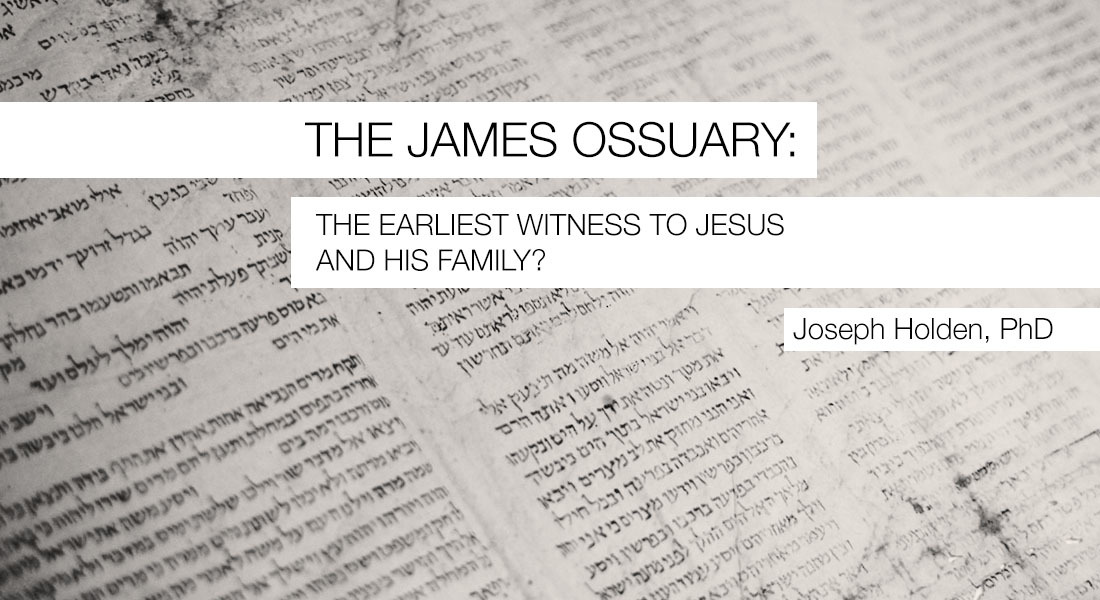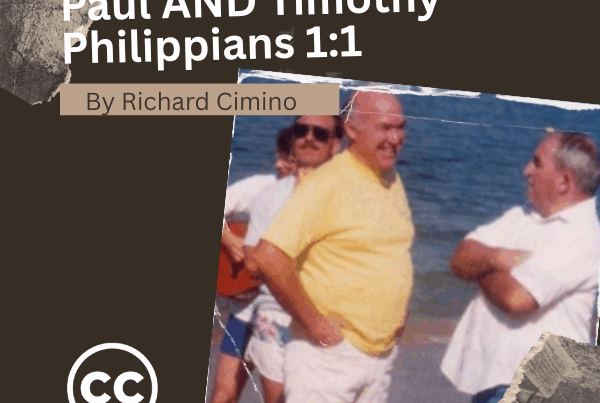
One of the earliest and most important discoveries relating to the historicity of Jesus and members of his family is the limestone bone-box (called an ossuary) made known to the public in October, 2002. Ossuaries were used by Israel from about the second century BC until the fall of Jerusalem in AD 70. Over ten thousand such ossuaries have been discovered but only about one hundred contain inscriptions. Of these, only two have an identification similar to the one etched in the now famous and somewhat controversial “James Ossuary.” The entire Aramaic inscription reads, “Jacob (James), son of Joseph, brother of Jesus” (Ya’akov bar Yosef akhui di Yeshua).

If, in fact, the inscription in its entirety is recognized as authentic (which we believe to be the case), we have clear first-century AD testimony of Jesus, his father Joseph, and brother James. James (Ya’akov) is given in the Gospel accounts as a brother of Jesus (Mt. 13:55), but he is also one of the most important figures in the New Testament. The book of Acts reveals that he was the pastor of the Jerusalem church, moderator of the Jerusalem Council in Acts 15, and penned the epistle of James. James is also spoken of a number of times in the writings of Josephus. He was put to death by certain Jewish leaders in AD 62, so if the James Ossuary is the one in which his bones were placed, then the dating of the bone-box would be approximately AD 62-63, allowing time for the reburial of the bones after the decomposition of the flesh, according to Jewish practices.
In December 2004, the Israeli Antiquities Authority (IAA) and the State of Israel brought an indictment against an antiquities dealer and owner of the James Ossuary, Oded Golan, claiming that the second part of the inscription (the portion which reads “brother of Jesus”) to be a forgery. This indictment seems to have came to nothing after five years of court proceedings that concluded in March 2010 with 116 hearings, 138 witnesses, 52 expert witnesses, over 400 exhibits, and more than 12,000 pages of court transcripts!1 According to Golan’s written summary of the trial (supported by the 474 page Hebrew language opinion handed down by Jerusalem District Court Judge Aharon Farkash on March 14, 2012), many high-level scholars with expertise in ancient epigraphy, paleography, bio-geology, and other crucial disciplines relating to examining the inscription have testified that there is no reason to doubt that the “brother of Jesus” was engraved by the same hand in the first century AD. In view of this, it is very likely that we may have a very early and important historical witness to Jesus and His family.2 A summary of the arguments for and against the authenticity of the inscription is listed below.
Arguments Against Its Authenticity
1. The ossuary was not discovered in situ, within a secure archaeological context, but rather obtained through the antiquities trade.
2. Though the bone-box itself and the first half of the inscription are not contested, arguments that the second half of the inscription (brother of Jesus) was recently engraved (forged) and was not completed by the same hand have been posited due to the absence of natural occurring patina.3 (Patina is a thin layer of biogenic material expected to be present on most, if not all, ancient artifacts to some degree. It is caused by the continuous secretions and activities of micro-organisms such as bacteria, fungi, algae, and yeast on the stone and inside some of its grooves. If the same consistency of patina is equally distributed on the ossuary and found within the engraved grooves, it would suggest the authenticity of the inscription. The absence of patina within the disputed portion of the inscription would suggest a forgery or modern engraving of letters.)
3. The foundation of the IAA’s case against Oded Golan was based on an eyewitness (Joe Zias, an anthropologist formerly employed by the IAA) that claimed to have previously seen the ossuary without the “brother of Jesus” portion of the inscription.
Arguments for Its Authenticity4
1. The size of the ossuary indicates that the bones belonged to an adult male, thus being consistent with James.
2. In 2004, while the ossuary was in IAA possession, the police (Mazap) made a silicon impression (cast) of the inscription that contaminated and mutilated the inscription. When the silicon was removed it also removed the natural occurring patina, but despite this action traces of the patina were still present in several of the letter grooves, indicating that the inscription is indeed ancient.
3. The name on the ossuary (James) reveals that the person was a male.
4. Ossuaries were only used by Jews only in the area of Jerusalem and from the end of the first-century B.C. until A.D. 70, the same time period that Josephus tells of the death of James at the hands of the Jewish religious leaders.
5. Of all those ossuaries bearing an inscription almost all speak of the deceased occupant’s father, but occasionally has the person’s brother, sister, or other close relative, if that person was well-known. The rare presence of a sibling’s name (Jesus) would indicate that Jesus was a very prominent figure.
6. Specialist and archaeologist, Prof. Kloner, dates the ossuary to between A.D. 45 – 70, and is thus consistent with the death of James in A.D. 62 according to Josephus.
7. Though the names Joseph, James, and Jesus are common names in the first-century, the combination of “James, son of Joseph” is rare and unique to this ossuary, meaning that it is highly probable that the bone-box belongs to James, Jesus’ brother even without the second half of the inscription mentioning this.
8. Prof. Camil Fuchs, head of the Statistic department at Tel Aviv University researched deceased males in Jerusalem in the first-century A.D. He concluded based on conservative estimates a growing Jerusalem population estimate (between A.D. 6-70), minus all women, minus children who will not reach manhood by time of James’ death, minus non-Jews, and considering the fame of Jesus as a brother to warrant the inscription, time of death, and literacy, that with 95% assurance there existed at the time in Jerusalem 1.71 people named James with a father Joseph and brother named Jesus!5
9. Golan affirms that he purchased the ossuary from an antiquities dealer who said it was found in the Silwan (Kidron Valley area) in Jerusalem. James the Just, pastor of the Jerusalem church6 and half-brother of Jesus7 was stoned and thrown from the pinnacle of the temple according to Josephus. According to Christian tradition, he was buried in a rock-cut tomb in the Kidron Valley, and one year later, in accordance with Jewish tradition, his bones were interned in an ossuary.8
10. Expert witnesses have confirmed that the inscription in its totality was inscribed by the same hand in the first-century, though this was a much disputed item (especially by Yuval Goren and Avner Ayalon) until experts were put under oath at trial.
11. Experts have confirmed the presence of microbial patina on the ossuary and both parts of the inscription “James, the son of Joseph” and “brother of Jesus,” demonstrating the unity and antiquity of the inscription. In addition, this patina is generally deemed ancient, without the possibility of it occurring naturally in less than 50-100 years, making a recent forgery impossible. The world’s leading expert in bio-geology and the patination process, Wolfgang Krumbeim of Oldenburg University in Germany, affirmed the patina on the ossuary and inscription most likely reflects a development process of thousands of years. He added that there is no known process of accelerating the development of patina. In addition, he concluded that the patina covering the inscription letters are no less authentic than the patina covering the surface of the ossuary (which the IAA says is authentic). Other researchers from the Royal Ontario Museum in Toronto confirmed that the patina within the letter grooves is consistent with the patina on the surface of the ossuary, thus legitimizing the entire inscription’s antiquity.
12. According to expert paleographers (Andre Lemaire and Ada Yardeni) who authenticated (and dated) the inscription based on the shape and stance of the letters, the Aramaic is fully consistent with first-century style and practice.9 No credible challenge to their findings has yet to be published.
13. Adding the words, “brother of Jesus” is exceptional among the ossuaries found in Jerusalem.10 During the trial, it was revealed that what eyewitness (Joe Zias, who does not read Aramaic) thought he saw (i.e. James Ossuary) was actually a different (but similar) ossuary with three Aramaic inscribed names (Joseph, Judah, Hadas) known as the “Joseph Ossuary.”11 Prior to rendering the final verdict by Judge Farkash, apparently Zias said to Hershel Shanks that he was “joking” when told that the “brother of Jesus” portion of the inscription was missing from the ossuary!12
So extensive and strong is the support for the authenticity of the ossuary and its inscription, according to Golan, Dan Bahat (the prosecutor), said in his closing arguments that the State would probably dismiss the charges that the ossuary inscription is a forgery.13 In fact, many of the IAA witnesses who initially claimed that the inscription was a forgery appeared to have changed their minds after closer analysis and scientific testing.14 What is more, many prosecution witnesses (witnesses for the IAA/State who argue that the inscription is a forgery) confirmed the authenticity of the inscription based upon careful analysis of the patina and the engraved inscription. The following chart offers a survey of several expert witnesses and their conclusions about the ossuary inscription.



Golan summarizes the outcome of extensive scientific tests performed on the ossuary and its inscription when he writes,
Neither the prosecution nor the IAA presented even a single witness who was an expert on ancient stone items, or patina on antiquities and who ruled out the authenticity of the inscription or any part of it. On the contrary, the findings of all the tests, including those of prosecution witnesses Goren and Ayalon, support the argument that the entire inscription is ancient, the inscription was engraved by a single person, and that several letter grooves contains traces of detergent/s that covers the natural varnish patina that developed there over centuries, and was partially cleaned (mainly the first section), many years ago.16
The apologetic and historical implications following from this ossuary are far-reaching since it informs us that: 1) James, Joseph, and Jesus have historical corroboration as individuals and a family in the first-century; 2) early Christians, like James, may have been buried according to Jewish custom; 3) Aramaic was used by early Christians; and that 4) early Christianity emerged from its Jewish roots, making it extremely difficult to divorce Christianity from its Jewishness. As such, the inscription’s primary apologetic value rests in the notion that after the most intense interdisciplinary expert scrutiny according to the rules of law, the James Ossuary is destined to be the most authenticated/scrutinized artifact in history. We now can appreciate the ossuary as an authentic artifact that provides the earliest direct archaeological link to Jesus and his family!
Copyright Joseph M. Holden, 2011, 2018. All Rights Reserved.
Sources
1 Oded Golan, “The Authenticity of the James Ossuary and the Jehoash Tablet Inscriptions – Summary of Expert Trial Witnesses,” (March, 2011), 1. The trial was brought to an end on March 14, 2012, when Jerusalem District Court Judge, Aharon Farkash, cleared the defendants (Oded Golan, Robert Deutsch, et al.) of all forgery charges (see Judge Farkash’s 474 page opinion in the case). The clearing of the forgery charges shows that the prosecution failed to demonstrate that the inscription was a forgery. As a result, there is no reason to doubt that the inscription in its entirety is an authentic description of Jesus and His family. This conclusion is supported by the dozens of expert witness named below and the script analysis offered by Andre Lemaire (Sarbonne) and Ada Yardeni (Hebrew University of Jerusalem) which gave them no reason to doubt the authenticity of the inscription. There is yet to be offered a reputable paleographical challenge to their conclusions on the matter. See James Brother of Jesus: The Forgery Trial of the Century with Hershel Shanks, editor, Biblical Archaeology Review (BAS, 2012).
2 Only Protestants would consider James to be the half-brother of Jesus through Joseph and Mary, since both the Roman Catholic Church and Eastern Orthodoxy believe that Mary remained a perpetual virgin. Roman Catholics consider James and the other brothers and sisters of Jesus in the Gospels to be cousins of Jesus through the supposed brother of Joseph. On the other hand, the Eastern Church believes that James and the other siblings were stepbrothers and stepsisters of Jesus born to Joseph from a former wife.
3 After testing the ossuary, clay specialist, Professor Yuval Goren of Tel Aviv University, initially championed the idea that ancient patina was missing from the second half of the inscription and that the forger must have used some other bonding substance or was a result from cleaning the inscription. However, subsequent examination of the inscription by Orna Cohen of the prosecution team revealed ancient patina in the word “Jesus’, thus discrediting Goren’s testimony and led Goren to reverse his initial conclusions.
4 Based on court transcripts and expert testimony summarized by Oden Golan, “The Authenticity of the James Ossuary and the Jehoash Tablet Inscriptions – Summary of Expert Trial Witnesses,” (March, 2011); also see arguments for authenticity put forth in Hershel Shanks and Ben Witherington III, The Brother of Jesus: The Dramatic Story & Meaning of the First Archaeological Link to Jesus & His Family. New York: Harper Collins, 2003
5 Hershel Shanks, “’Brother of Jesus’ Proved Ancient and Authentic” in A Biblical Archaeology Press Release (Washington D.C., June 13, 2012); Hershel Shanks, “’Brother of Jesus’ Inscription is Authentic!” in BAR 38:04, July/August 2012.
6 Confirmed by his role at the council of Jerusalem and the words of Eusebius.
7 The evidence appears clear that James was truly the half-brother of Jesus and son of Mary. The perputal virginity of Mary was not taught at the earlier periods of the church and even was rejected by Augustine. The word for brother in Greek is ἀδελφός (adelphos), while the word for cousin is ἀνεψσιός (anepsios). BDAG, 78. Louw and Nida, 118, say, “The interpretation of ἀδελφός in such passages as Mt 12.46; Mk 3.31; and Jn 2.12 as meaning ‘cousins’ (on the basis of a corresponding Hebrew term, which is used in certain cases to designate masculine relative of various degrees) is not attested in Greek nor affirm in the Greek-English lexicon edited by Arndt, Gingrich, and Danker. Such an interpretation depends primarily on ecclesiastical tradition.” The relationship is confirmed by the second-century father Hegesippius where he distinguishes James and Jude as brothers. Moreover Jude in his letter says that he is the brother (ἀδελφός) of James. Matt 1:25 is plain that the lack of sexual relations between Joseph and Mary was only until the birth of Jesus. It was morally proper for Jewish husbands and wives to have sexual relations and bear children, in contrast to some of the extreme ideas of celibacy practiced in some segments of the patristic period. The church historian Eusebius says that James was the head of the Jerusalem church and was brother of Jesus.
8 Oded Golan, “The Authenticity of the James Ossuary,” (March, 2011), 13-15.
9 Shanks, “’Brother of Jesus’ Inscription is Authentic!” in BAR 38:04, July/August 2012.
10 Paul L. Maier, “The James Ossuary,” Issues, Etc. https://www.mtio.com/articles/b… (last visited November 13, 2011).
11 Shanks, “’Brother of Jesus’ Inscription is Authentic!” in BAR 38:04, July/August 2012; also see the record of the defense’s cross-examination of Joe Zias in the Hebrew court transcript at: https://bib-arch.org/pdf/trial-…
12 See Strata: “Joe Zias: ‘Hershel Shanks Has No Sense of Humor’” in BAR 38:03, May/June 2012.
13 Golan, The Authenticity of the James Ossuary, 13, (page 11462 of the Hebrew language court transcript).
14 This can be seen on several fronts such as comparing earlier and later court documents, and comparing the later Golan, The Authenticity of the James Ossuary (2011) with earlier accounts of IAA witnesses recorded in Hershel Shanks and Ben Witherington III, The Brother of Jesus: The Dramatic Story & Meaning of the First Archaeological Link to Jesus & His Family. New York: Harper Collins, 2003.
15 Chart is based on the summary of court proceedings offered by Oded Golan, “The Authenticity of the James Ossuary,” (March, 2011), 1-15.
16 Golan, The Authenticity of the James Ossuary, 10.






